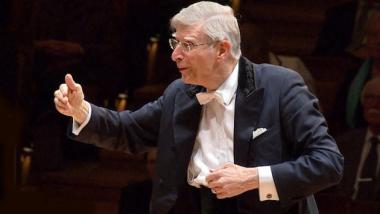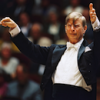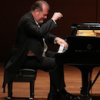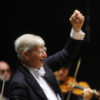
“Come for Beethoven ... Stay for Stenhammar!”
That should have been the advertising for the San Francisco Symphony concert series this week: Beethoven’s “Emperor” Concerto to bring in the audience, the San Francisco premiere of Swedish composer Wilhelm Stenhammar’s 1915 Symphony No. 2 as the novelty and, for some, the challenge.
The “Beethoven angle” was widely touted, and it filled the house on Saturday, but it must have been standing-room-only at the Thursday and Friday performances too, if only Davies Hall had such a space.
The Stenhammar “novelty” had its little-advertised introduction after the intermission, with only a handful of patrons leaving before the performance, the audience resisting the temptation to leave on a high after Garrick Ohlsson’s titanic performance in the concerto.
Responsible for the bold programming and grand presentation: S.F. Symphony Conductor Laureate Herbert Blomstedt, who, at the age of 90, continues to lead orchestras around the world, including this one, which he headed from 1985 to 1995.
As then and as now, Blomstedt, whose age is evident only in a slight stoop in his military-athletic bearing, advocates for great composers whose magnificence is underappreciated in the New World. His missionary work on behalf of Carl Nielsen, Anton Bruckner, and other, underperformed masters has made even the far reaches of the West Coast a home for them, including an acclaimed S.F. Symphony recording of all six Nielsen symphonies.
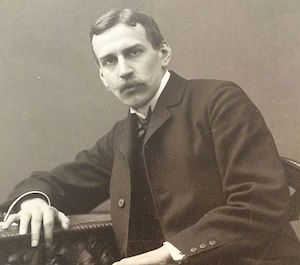
And so to a fellow countryman of Swedish-American Blomstedt: Stenhammar (1871-1927), who was a highly regarded pianist, composer, and conductor, a champion of both German and Scandinavian romantics. But by the time he composed the Second Symphony, at age 44, there was little of Wagner or Brahms remaining in the music: it is more Swedish folk music and homage to Sibelius.
There is consistent forward momentum and rhythmic variety in the music, but also constraint and subtlety, rather than drama and emotional peaks. Stenhammar’s tempo markings for the four movements (Allegro, Andante, Scherzo, Sostenuto) has more variety than the music itself expresses.
At times, I heard subtle harbingers of the grand film scores from the 1940s, the work of refugee composers from Central Europe and Germany — romantic, but more accompaniment than something up front. Even the frequently used folkdance rhythms seemed tamped down, rather than pulling the listener out of the seats to trip the light fantastic. Not surprisingly, this music from Sweden has Scandinavian attributes of caution and reserve although the fourth movement almost breaks out of that (probably oversimplified) characterization.
Under Blomstedt’s knowing and loving direction, the orchestra, especially the strings, performed with impressive cohesion and consistency. This being a Saturday concert, it’s worth recalling that during his S.F. Symphony days. and in all his career, the devout Seventh-day Adventist conductor has not ever rehearsed on the Friday-Saturday Sabbath, but he does conduct concerts, considering performances to be expressions of devotion rather than work.
Spirituality was palpable frequently during the evening, most memorably at the beginning of the second movement of the Beethoven concerto. Blomstedt and Ohlsson overcame the traditional and unfortunate audience celebration at the climactic end of the Allegro, the pianist extending the final note, the conductor motioning for continuation of the music before applause. And then came the magical hush of the Adagio on muted strings, inviting the piano to speak.
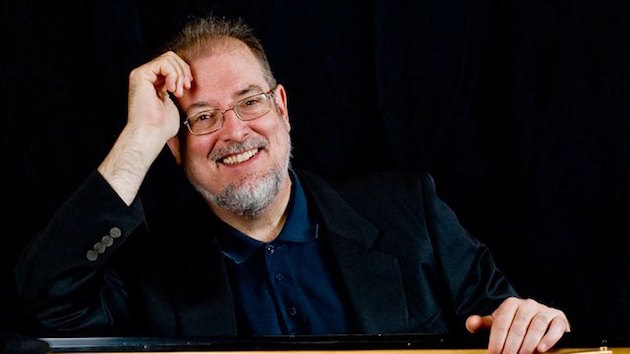
Speaking is what Ohlsson was doing throughout the work, clearly, lucidly, gorgeously. This is a concerto of temptations to go max, to overdo, from the triumphant themes in the first-movement Allegro to the fast, robust Rondo, but Ohlsson’s artistry was never compromised. His brilliant technique provided a firm platform for communicating the essence, the beauty of the music. Pianist, conductor, orchestra were as one in this performance to be treasured.
The standing ovation was cut short by Ohlsson, who gave a wonderful encore without making the audience keep asking for it. Channeling the sound of the concerto’s lyrical Adagio, he played the first movement of Beethoven’s Piano Sonata No. 28 in A Major, a quiet, complex piece, marked perfectly as “Etwas lebhaft, und mit der innigsten Empfindung” (Somewhat lively, and with innermost sensibility). Innermost ... and topmost it was.

